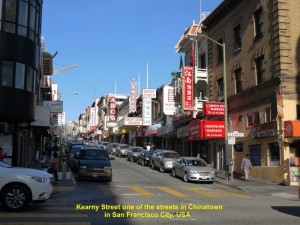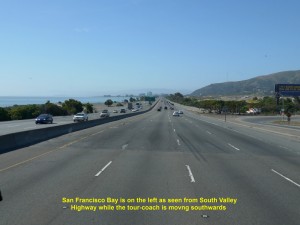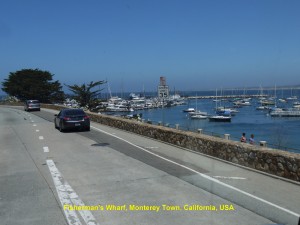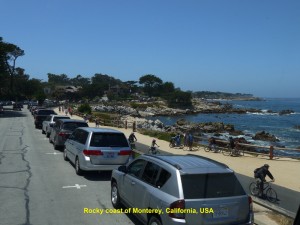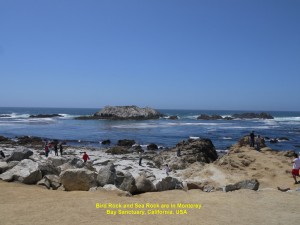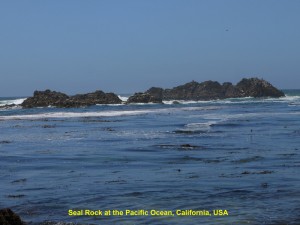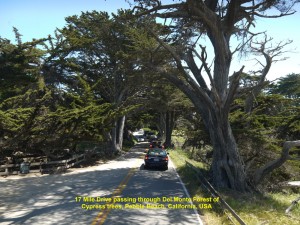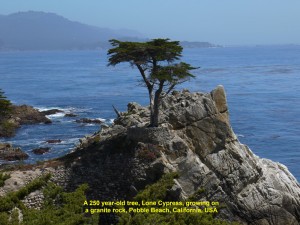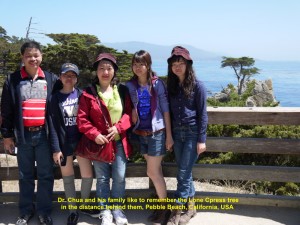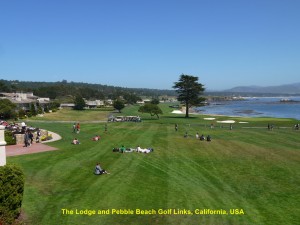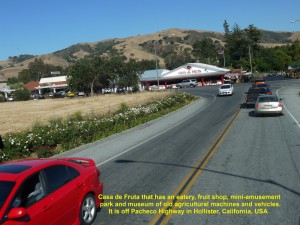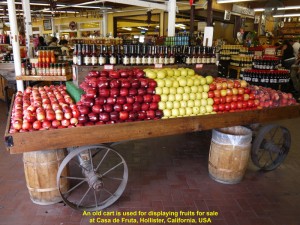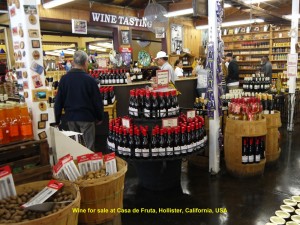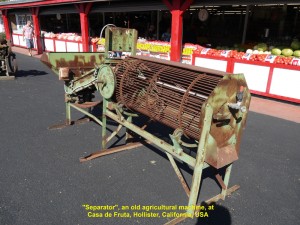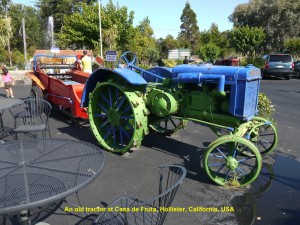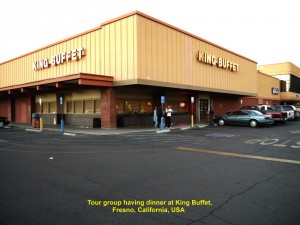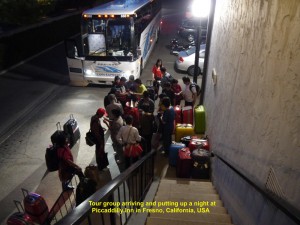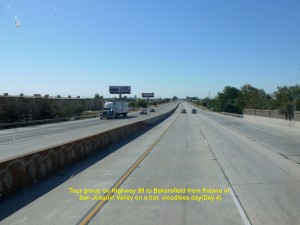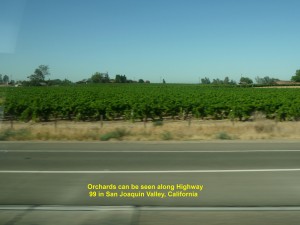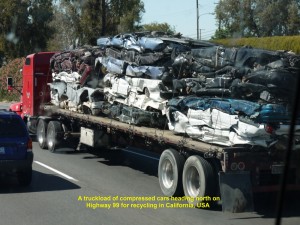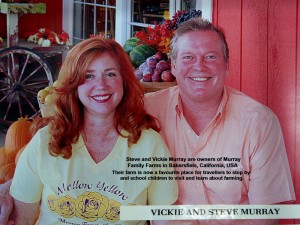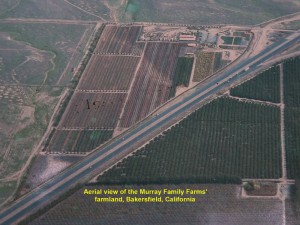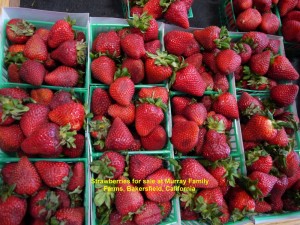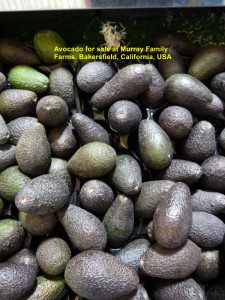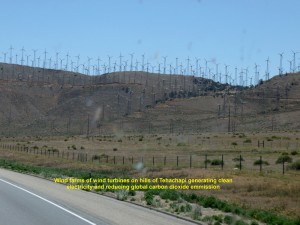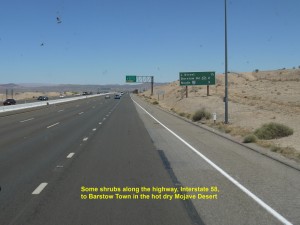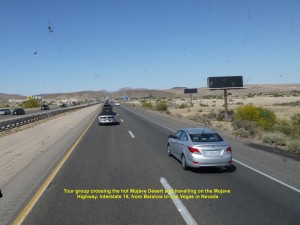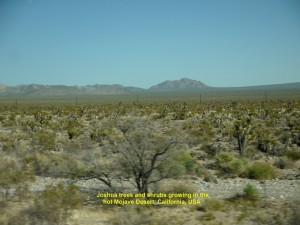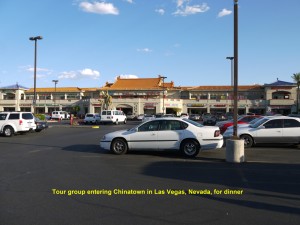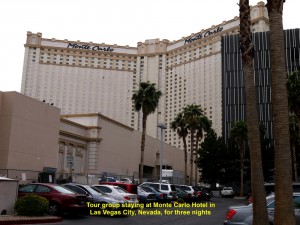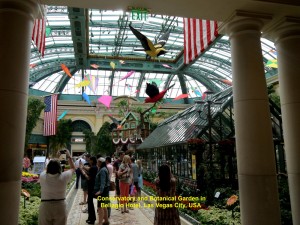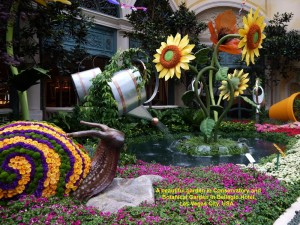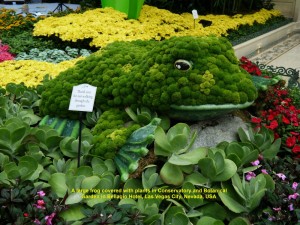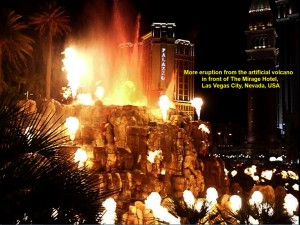USA West Coast Travel Part II (San Francisco-Fresno-Las Vegas)
Filed under: USA, USA West Coast Travel (Part II}, USA West Coast Travel Part II (San Francisco - Las Vegas)
USA West Coast Travel Part II (San Francisco-Fresno-Las Vegas)
Day 3(Sunday, 25.5.2014)
San Francisco – Monterey
(185 km)
California
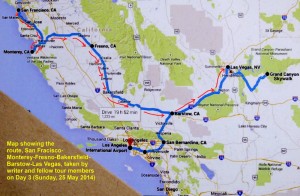
Route from San Francisco to Las Vegas via Monterey taken by tour group on Day 3(Sunday, 25 May 2014)
Chinatown in San Francisco
In the morning of Day 3, we went to a Chinese restaurant, P & R Restaurant, along Kearny Street, in Chinatown in San Francisco City to have breakfast. We had ‘dim sum’, a Chinese breakfast that included “chia siu pau”(steamed barbecue pork dumplings), chicken legs, “low mai gai” (sticky rice wrapped in lotus leaves), “har gau”(shrimp dumplings), pork ribs and tea.

Tour group having “dim sum” breakfast at P & R Restaurant, a Chinese restaurant in Chinatown, San Francisco City, USA
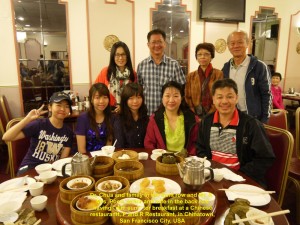
Writer with some fellow-tour members having “dim sum” at P & R Restaurant, Chinatown, San Francisco City, USA
After that simple meal at 9.30 a.m., we left San Francisco City and moved southwards to Pebble Beach which was more than 180 km away.

Tour group is leaving San Francisco City for Pacific Glove and Pebble Beach in the south, California, USA
First, we were travelling on South Valley Highway and saw San Francisco Bay on our left. Then we were on Cabrillo Highway that crossed an undulating land. Soon it was running parallel to the Monterey Bay coastline.

Tour group travelling on Cabrillo Highway that crosses undulating land to Monterey in the south, California, USA

Tour group travelling south to Pebble Beach on Cabrillo Highway that runs parallel to the Monterey Bay coastline, California, USA
Monterey Town
At 1.00 p.m. we arrived at Monterey Town and had lunch at a restaurant, Chinese Garden Restaurant.
An hour later we resumed our journey. We passed New Fisherman’s Wharf and rocky coast of Monterey Town.

Tour group have lunch at this Chinese restaurant, Chinese Garden Restaurant, in Monterey Town, California, USA
Several minutes later, we came to a toll-gate. When our coach-driver had paid a fee at the gate he drove us on and entered Pacific Grove on the Monterey Peninsula. This place is well-known for Victorian houses and monarch butterflies that migrate there in large numbers, annually.
17 Mile Drive
Then we were travelling on a coastal road, 17 Mile Drive. This road passes by scenic coasts of Pacific Ocean, through Del Monte Forest of Cypress trees, famous golf-courses and large luxurious mansions.
Bird Rock and Seal Rock
After travelling a few kilometres of the road from the toll-gate, we stopped at a beach for a while to see two significant barren rocks at the Monterey Bay Sanctuary about 200 metres off the beach. One was inhabited by seagulls, pelicans and cormorants, and is known as Bird Rock, whereas the other one was occupied by seals and therefore known as Seal Rock. The Bird Rock was almost completely white as it had been covered with a thick layer of birds’ droppings over many years. Besides the birds and seals we saw on the rocks, we also saw some furry squirrels running about on the sandy beach without fear of human beings.
Lone Cypress
Then we continued our journey. Later, we passed through Del Monte Forest of cypress trees and went to a high ground where we alighted our coach. Standing on the edge of a cliff, we saw a tree standing alone in a distance on a rugged, bare, granite headland at Carmel Bay, and felt its loneliness. Being known as “Lone Cypress”, it was believed to be 250 years old and hoped it would live for another 50 years.
Pebble Beach
Then we went to Lodge and Pebble Beach Golf Links(a golf course) which were near the lonely cypress tree. They belong to Pebble Beach Company which was founded by Samuel F.B. Morse in 1919. The company also owns 5 300 acres of Del Monte Cypress Forest, Pacific Grove and Pebble Beach areas, Del Monte Rancho, Hotel Del Monte, and a few more properties on Monterey Peninsula. It is interesting to note that it has made the picture of Lone Cypress as its logo.
Pebble Beach Lodge is a place for shopping and dining. Besides, it has a world-famous golf course which is known as Pebble Beach Golf Links. It holds AT & T Pebble Beach National Pro-Am Tournament, annually. Besides, it has held five prestigious US Open Championships. The former tournament replaced Bing Crosby Pro-Am Golf Tournament(1937 – 1985) in 1986.
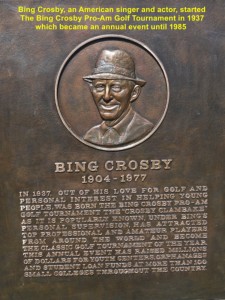
Bing Crosby(1904 – 1977), an American singer and actor, started the annual event “Bing Crosby Pro-Am Golf Tournament” in 1937 until 1985.
Pebble Beach Golf Links is a beautiful, well-maintained golf course located by a rugged coastline facing the Carmel Bay and south of Monterey Town.
Casa de Fruta
After spending several minutes at the lodge and the golf course, we travelled eastwards at 3.30 p.m. to Fresno which is over 200 km from Pebble Beach. At 5.00 p.m. we stopped at a fruit-shop known as Casa de Fruta which was selling all kinds of fruits, like peaches, apricots, oranges, plums, apples, etc. Besides, it was selling dried fruits, nuts, wine, etc.
In its compound it exhibited some old but interesting agricultural machines and vehicles, such as old tractors, “separator”, trucks and ground levelling machine, to name a few.
At 5.30 p.m. we left the fruit shop. On the way to Fresno, we saw orchards along the road and a herd of cattle on grassland, and the weather was hot. Fortunately, we were travelling in an air-con coach.
San Luis Reservoir
Soon we saw a large reservoir with low water-level due to dry season. It was San Luis Reservoir, an artificial lake, and its water is used for farm irrigation and other purposes.
Fresno
At 7 p.m. we, finally, arrived at Fresno and had a buffet dinner at a restaurant, King Buffet. After dinner we went to an inn nearby, Piccadilly Inn, where we stayed overnight.
Day 4 (Monday, 26.5.2014)
Fresno – Las Vegas
At 8.30 a.m. of Day 4, we left Fresno for Bakersfield. We were travelling south-east on a highway, Golden State Highway(Route 99), which was on a flatland. It passed through orchards, farmlands and small towns.
California Aqueduct
As rainfall in these areas in Southern California is little, they get water from the California Aqueduct. The aqueduct is a system of canals, tunnels, and pipelines that transport water collected from the Sierra Nevada Mountains and valleys of Northern and Central California to dry lands in Southern California.
Apple Annie’s Restaurant
At 9.30 p.m. we reached Tulare Town where we stopped at a restaurant, Apple Annie’s Restaurant, for breakfast. Several minutes later, we were off again on the same highway. At one time I saw a truck on the road carrying more than 30 cars, but those cars had already been reduced in size and on the way to a factory for recycling.
Murray Family Farms
At 11.00 a.m. we arrived at Bakersfield where we visited a farmland, Murray Family Farms, belonging to a couple, Steve and Vickie Murray. Besides fruits, the couple also planted vegetables in their farms. They had built a large building which was painted bright red in front. It housed a restaurant and place where their produce from their farms was displayed for sale. Their farmland had become a popular place where travellers like to visit for a short while.
As the farm had two corn mazes, petting zoo, ant farm, butterfly house, “pick-your-own-fruits” areas and a few more interesting places, it attracted school-children too.
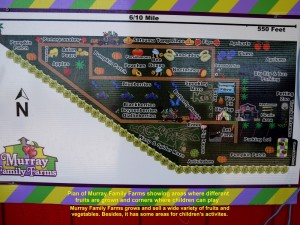
Plan of Murray Family Farms showing fruit and vegetable growing areas and children’s activity corners
Wind Turbines
After spending several minutes at Murray Family Farms, we continued our journey. We travelled eastwards on a highway, Interstate 58. While travelling across the hilly, hot, dry land, we did not see any vegetation. Several minutes later, we saw some trees and shrubs growing on hills and flat land, and passed through a few small towns. Later, in Tehachapi, we saw countless number of wind turbines on hills spinning to generate clean electricity and reduce emission of hundreds of thousands of tons of carbon dioxide, annually.
Barstow Town
At 1 p.m. we arrived at Barstow Town and stopped at a restaurant, Sizzler, to have steak with bread and potato chips, salad and ice-cream for lunch. Then at 2 p.m, we continued our journey travelling on another highway, Interstate 15.
Tanger Outlets
Several minutes later, we came to a shopping centre, Tanger Outlets, where 36 shops were selling accessories, jewellery, apparel, footwear, etc. The temperature there shot up to 39 degrees Celsius and the heat was, extremely, unbearable! At 4 p.m. we moved on again. We were crossing a hot, uninhabitable land of Mojave Desert.
Valley Wells
At about 5 p.m. we arrived at a rest area, Valley Wells, in the Mojave National Preserve and answered a call of nature. No dwellings except desert shrubs, Joshua trees, sand and distant barren hills were seen in the hot desert area. A mountain range, Clark Mountain Range, could be seen in the distance from the Valley Wells rest area and highway, Interstate 15. The highest mountain of the range, Clark Mountain, which was 2 418 metres high was the highest mountain in Mojave Desert in California.
Ivanpah Solar Power Plant
Several minutes later, we resumed our journey. At 5.30 p.m. we saw an extremely bright area in the distance in Ivanpah Valley which was about 8 km from California-Nevada border. It was a solar power plant consisting of thousands of large mirrors that focused the sun’s energy on solar receivers atop power towers generating electricity that could meet the need of 140 000 homes. It was the largest solar thermal power plant in the world.
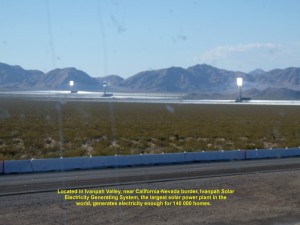
A solar power plant, the world largest plant, in the Ivanpah Valley near the California-Nevada border, USA

A loving, old couple of the tour group are feeling hot in the air-con coach while crossing the Mojave Desert in California
Primm and Jean
Soon we reached the California-Nevada border. As we crossed the border we entered a town, Primm, in Neavada where there were hotels and casinos. Later, we passed by another town, Jean, in Nevada where there were hotels and casinos too. Those places tempted residents in California to cross the border and gamble at their casinos. Gambling in Nevada state is legal. The Great Depression of 1929 and Hoover Dam Project(1931-36) led to the legalisation of gambling in Nevada in 1931. Now tax on gambling contributes the largest portion of the income of Nevada.

Tour group entering a California-Nevada border town, Primm, in Nevada where hotels and casinos attract Californians

Tour group came across another town, Jean, in Nevada where hotels and casinos exist, especially, for Californians.
Las Vegas City, Nevada
After a whole day of travelling, we finally arrived at our destination, Las Vegas, at 6.20 p.m.
Located in Mojave Desert in Clark County in Nevada, Las Vegas was established in 1905. With a population of more than half a million, it is a well-known city in the world for gambling, shopping, dinning and nightlife. Besides, it is a popular place for conventions, business and meetings. It is known as the “Entertainment Capital of the World”. It is also known as the “Sin City” because it has various kinds of adult entertainment.
Chinatown, Las Vegas City
After entering Las Vegas, we went straight to Chinatown to have a Chinese dinner at Harbor Palace Seafood Restaurant. The meal was delicious and the dish that I like best was roasted Peking duck.

Tour group having dinner at Harbor Palace Seafood Restaurant in Chinatown, Las Vegas City, Nevada, USA

Writer’s favourite dish at Harbor Palace Seafood Restaurant in Chinatown, Las Vegas City, Nevada, USA
Monte Carlo Hotel
After dinner we went to one of the grand hotels in the city, Monte Carlo. where we would stay for three nights. When we had left our luggage in our respective rooms in the hotel, Wang, our coach driver, brought us to a place to see a musical fountain. It was in front of a luxurious hotel, Bellagio Hotel.
Musical Fountain
The fountain is in a man-made lake consisting of more than 1 200 nozzles that can shoot water as high as 140 metres, and 4 500 lights that will coordinate with the nozzles during the “action”.

At 8 p.m. sharp, the musical fountain started to show off its splendid dance in front of Bellagio Hotel in Las Vegas City
At 8 p.m. sharp, the musical fountain surrounded by many visitors started to show off its splendid watery dance with the accompaniment of thousands of bright lights and some soft musics, like “Time to Say Goodbye”,”Proud to be an American”, “Your Song”, “Viva Las Vegas” and “My Heart Will Go On”. We and other visitors were delighted for five minutes watching the spectacular fountain display.
Bellagio Hotel
When the musical fountain elegant performance ended we went inside Bellagio Hotel and visited its Conservatory and Botanical Garden. It is a place that undergoes changes five times a year according to the four seasons and the Chinese New Year.
When we entered the place we thought we were in a paradise for one moment. The place was awesome. It was full of different kinds of colourful flowers in full bloom as it was spring time. Besides, there were some large animal-figures like frogs and snails and two life-size horses that add variety to the colourful place. Some figures were covered with flowers or plants including a frog and two snails. Small non-flowering plants were growing in a small conservatory in the centre of the place.

Conservatory and Botanical Garden growing flowering and non-flowering plants in Bellagio Hotel, Las Vegas City

A musician entertaining visitors in Conservatory and Botanical Garden area in Bellagio Hotel, Las Vegas City, Nevada, USA
“Volcano” at Mirage Hotel
Then we left the place and went to another hotel, The Mirage, to watch an artificial volcano that could “erupt”. When we arrived at the hotel, we were in time to watch the volcano starting to spill out fire and “lava”, and then “eruption” occurred several times. Whenever it “erupted” a big fire covered a large area making spectators feel hot. The “volcanic activity” lasted for about seven minutes.
After that fiery “volcanic eruption” show, we went to an old street, Fremont Street, in Las Vegas Downtown, where the old hotels and casinos still existed. It was once a popular tourist place until the Strip which was a stretch of South Las Vegas Boulevard was opened. There were larger and more hotels and casinos in the Strip area.
Fremont Street Experience
To lure the tourists back, a stretch of Fremont Street was given a face-lift in 1994. A canopy of 460 metres long and 27 metres high covered the street making it a pedestrian mall or Fremont Street Pedestrian Mall or Fremont Street Experience. Besides, the canopy was a LED screen, the longest in the world, consisting of over 12 millions LED lights. The screen would hold shows, several minutes each time and once in every hour from dusk until midnight. There were two stages where concerts were held every night. Consequently, the street was crowded with tourists again.

Fremont Street Experience in Fremont Street in Las Vegas Downtown introduced in 1994 attracting tourists. The overhead canopy LED screen is the longest in the world.

Fremont Street Experience in Las Vegas Downtown providing visitors many experiences in canopied Fremont Street
At 9.30 p.m. we arrived at a place near Fremont Street and alighted the coach. Then we walked to the canopied street. As we entered the street we saw a large crowd watching a few singers on a stage singing country songs to the accompaniment of a band.
While walking further down the street we saw street entertainers, man and ladies impersonating famous film-stars and singers, “transformers”, etc.
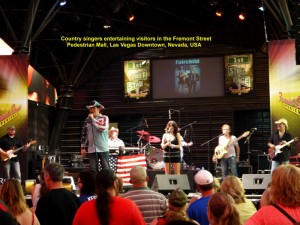
Country singers entertaining visitors in Fremont Street Pedestrian Mall in Las Vegas Downtown, Nevada, USA
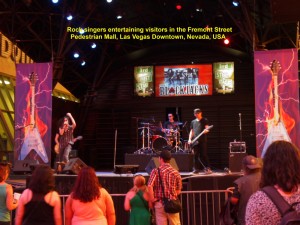
Rock singers entertaining visitors in the Fremont Street Pedestrian Mall in Las Vegas Downtown, Nevada, USA
But we were shocked to see some men and ladies dressed in “bling, bling” costumes that did not cover much of their bodies. They were inviting visitors to take photos with them for a fee. Then suddenly bright lights went off and the overhead long LED screen began a show that lasted for a few minutes. It showed interesting colourful images of the past, present and future developments.

Musicians getting ready to entertain visitors in the Fremont Street Pedestrian Mall in Las Vegas Downtown, Nevada, USA
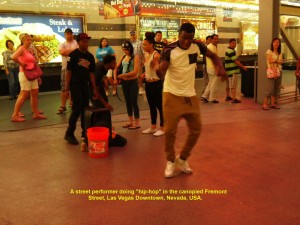
A street performer doing a hip-hop dance in the Fremont Street Pedestrian Mall in Las Vegas Downtowm, Nevada, USA

An artist doing funny caricatures of visitors in his mini-studio in the Fremont Street Pedestrian Mall in Las Vegas Downtown, Nevada, USA

The Fremont Street Pedestrian Mall in Las Vegas Downtown where visitors can experience many activities
At 10.30 p.m. we left the Fremont Street Pedestrian Mall, boarded our coach, and went back to our hotel, Monte Carlo Hotel, which was a kilometre away, to rest our tired bodies.
(Continued in USA West Coast Travel Part III (Grand Canyon, Arizona))
U.S.A West Coast Travel:
Part II San Francisco, Fresno. Las Vegas
Part V Premium Outlets in S, California
Part VI Disneyland Resort, Anaheim
Part VII Hollywood Walk of Fame, Los Angeles

